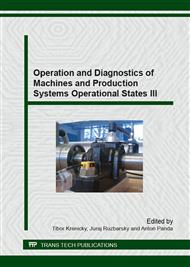[1]
Ľ. Straka, S. Fabian, Modelling of selected reliability indicators of prototype PAM equipment. In: Applied Mechanics and Materials 460 (2014) 91-98.
DOI: 10.4028/www.scientific.net/amm.460.91
Google Scholar
[2]
P. Stephen, P. S. Radzevich, R. Kreheľ, Application priority mathematical model of operating parameters in advanced manufacturing technology, International Journal of Advanced Manufacturing Technology 56/2 (2011) 835-840.
DOI: 10.1007/s00170-011-3221-x
Google Scholar
[3]
R. Kreheľ, Ľ. Straka, T. Krenický, Diagnostics of production systems operation based on thermal processes evaluation, Applied Mechanics and Materials 308 (2013) 121-126.
DOI: 10.4028/www.scientific.net/amm.308.121
Google Scholar
[4]
S. Fabian, Ľ. Straka, Operation of production systems, FMT TUKE, Prešov, (2008).
Google Scholar
[5]
P. Čačko, T. Krenický, J. Dobranský, Impact of an excessive wear of bearing on the mechatronic devices, Applied Mechanics and Materials 460 (2014) 99-106.
DOI: 10.4028/www.scientific.net/amm.460.99
Google Scholar
[6]
S. Fabian, T. Krenický, I. Čorný, Operation and Diagnostics of Machines and Production Systems Operational States. Trans Tech Publications, Zurich, (2013).
Google Scholar
[7]
T. Krenický, Implementation of Virtual Instrumentation for Machinery Monitoring, in: Scientific Papers: Operation and Diagnostics of Machines and Production Systems Operational States: Vol. 4, RAM-Verlag, Lüdenscheid, 2011, pp.5-8.
Google Scholar
[8]
P. Malega, Comparison of management bottlenecks systems in production process, Transfer innovation 26 (2013) 152-157.
Google Scholar
[9]
J. Mihalčová, Using Atomic Spectrometry and Volumetry Method for Determination of Bearing Corrosion in Tribotechnical Diagnostics of Engines, Applied Mechanics and Materials 616 (2014) 110-117.
DOI: 10.4028/www.scientific.net/amm.616.110
Google Scholar
[10]
I. Čorný, M. Fedák, M. Rimár, Chilled Ceiling Adaptive Control with Application of Parameters Gained from the Chilled Ceiling System Proposal Algorithm, Applied Mechanics and Materials 616 (2014) 317-324.
DOI: 10.4028/www.scientific.net/amm.616.317
Google Scholar
[11]
M. Neslušan et. al., Experimental methods in splinter machining, EDIS ŽU Žilina, (2007).
Google Scholar
[12]
A. Panda et al., Turning bearing rings and determination of selected cutting materials durability, Advanced Science Letters 19/8 (2013) 2486-2489.
DOI: 10.1166/asl.2013.4943
Google Scholar
[13]
A. Panda, M. Prislupčák, I. Pandová, Progressive technology diagnostic and factors affecting to machinability. In: Applied Mechanics and Materials 616 (2014) 183-190.
DOI: 10.4028/www.scientific.net/amm.616.183
Google Scholar
[14]
A. Panda, J. Duplák, Comparison of theory and practice in analytical expression of cutting tools durability for potential use at manufacturing of bearings, Applied Mechanics and Materials 616 (2014) 300-307.
DOI: 10.4028/www.scientific.net/amm.616.300
Google Scholar
[15]
J. Paško, Š. Gašpár, J. Ružbarský, Die casting defects of castings from silumin, Applied Mechanics and Materials 510 (2014) 91-96.
DOI: 10.4028/www.scientific.net/amm.510.91
Google Scholar
[16]
J. Ružbarský, J. Paško, Š. Gašpár, Techniques of Die Casting, RAM-Verlag, Lüdenscheid, (2014).
Google Scholar
[17]
J. Ružbarský, Dynamics of core taking out at die casting, Applied Mechanics and Materials 616 (2014) 244-251.
DOI: 10.4028/www.scientific.net/amm.616.244
Google Scholar
[18]
Š. Salokyová, S. Fabian, The influence of abrasive mass flow on vibrations in the water jet cutting process, Výrobné inžinierstvo 1 (2011) 31-33.
Google Scholar
[19]
S. Fabian, Š. Salokyová, AWJ cutting the technological head vibrations with different abrasive mass flow rates, Applied Mechanics and Materials 308 (2013) 1-6.
DOI: 10.4028/www.scientific.net/amm.308.1
Google Scholar
[20]
Ľ. Straka, I. Čorný, R. Kreheľ, Evaluation of capability of measuring device on the basis of diagnostics, Applied Mechanics and Materials 308 (2013) 69-74.
DOI: 10.4028/www.scientific.net/amm.308.69
Google Scholar
[21]
Ľ. Straka, Operational reliability of mechatronic equipment based on pneumatic artificial muscle, Applied Mechanics and Materials 460 (2014) 41-48.
DOI: 10.4028/www.scientific.net/amm.460.41
Google Scholar
[22]
J. Dobranský, R. Mikuš, J. Ružbarský, Comparison of cooling variants by simulation software, Advanced Materials Research 801 (2013) 75-80.
DOI: 10.4028/www.scientific.net/amr.801.75
Google Scholar
[23]
P. Stephen, P. S. Radzevich, R. Kreheľ, Determination of the grinding wheel profile and its setup for use in finishing cylindrical gears with an evolvent profile, International Journal of Advanced Manufacturing Technology 63 (2012) 1-5.
DOI: 10.1007/s00170-012-3982-x
Google Scholar
[24]
M. Tóthová, J. Piteľ, J. Mižáková, Operating modes of pneumatic artificial muscle actuator, Applied Mechanics and Materials 308 (2013) 39-44.
DOI: 10.4028/www.scientific.net/amm.308.39
Google Scholar
[25]
A. Vagaská, Mathematical description and static characteristics of the spring Actuator with Pneumatic Artificial Muscle, Applied Mechanics and Materials 460 (2014) 65-72.
DOI: 10.4028/www.scientific.net/amm.460.65
Google Scholar
[26]
S. Šoltésová, P. Baron, The operation monitoring condition of the production machinery and facilities using the tools of technical diagnostics, Applied Mechanics and Materials 308 (2013) 105-109.
DOI: 10.4028/www.scientific.net/amm.308.105
Google Scholar


